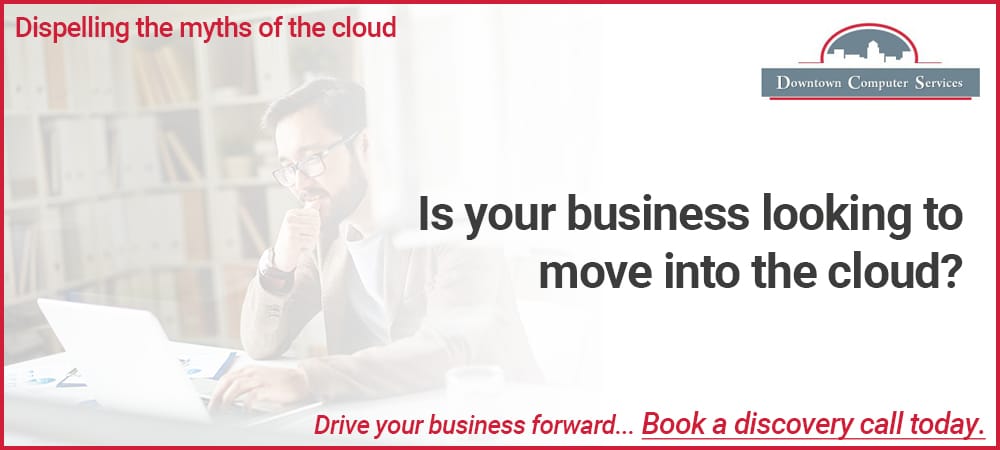
01 Jul Dispelling the myths of the Cloud – The technical jargon
In the first blog of this two-part series, we discovered what the Cloud is and dispelled some of the myths that cause the most apprehension from business owners when thinking of implementing it. In the following blog we will explore another cause for concern relating to utilization of the Cloud. The technical jargon used when talking about the Cloud can be like listening to a foreign language, but, once you learn it, the benefits will be considerable.
Let’s break down some of the technical jargon now and, hopefully, in the process, make your onboarding conversations with a provider much easier to navigate.
The technical jargon explained
IaaS – Infrastructure-as-a-Service
Infrastructure-as-a-Service is a computing framework that is provided over the internet. Your provider will supply and manage the infrastructure that your software resides on, on a subscription basis. IaaS isn’t easy to understand and, therefore, it is highly recommended that you get an IT specialist with experience in the field to assist you in purchasing, installing, configuring, and managing your software.
SaaS – Software-as-a-Service
Software-as-a-service is the delivery of applications, the storage of data within those applications and – dependent on your provider – the security and back-up of that data too, which is applied all over the internet as a contractually paid service. SaaS is more common than you may think – some of the most popular ones are at the heart of several of the biggest organizations in the world, including Microsoft 365, Google Workspace, and Zero Accounting. SaaS allows you to be free of having to manage your software and hardware management tasks that – especially for the less technically competent – can be time-consuming and completely impossible for some.
Cloud applications
A Cloud application (more commonly known as a Cloud app) is the software you access online instead of installing and accessing it on individual computers.
Now we have dispelled some of the myths surrounding the Cloud, let’s take a look at some of the business benefits to be achieved by implementing it.
Cloud storage
Cloud storage is exactly as the title suggests – storage. And, yes, most have storage already. The sole aim of Cloud Storage is to irradicate the large storage and management requirements from individual computers and servers, in the process making them much more fluent and more secure. When your data is ‘saved to the Cloud’ it means that your data is stored in remote servers and is now available to be accessed from multiple devices (as long as those individuals have the right access permissions).
Business positives of the Cloud
Collaboration
Remote working has become very popular all around the world, but, because of this, some business owners have found it hard to collaborate. The Cloud makes it possible to mirror the levels of collaboration achieved in the office. Your team – no matter their location around the globe – can work simultaneously on the same documents. Applications such as Microsoft Teams also allow for communication from anywhere. The Cloud allows you to achieve so much from the comfort of your own home, the office, the beach, or anywhere you can imagine that has internet connection. Over the coming years, it will continue to excel and further extend the boundaries of what is possible by utilizing technology. It has the power to revolutionize the workplace forever.
Back up & continuity of business
As rare as they are business-defining disasters do happen, and when they do you need a way to access your data quickly – the Cloud makes this possible. It allows you to carry on business as usual – whilst avoiding the potentially very expensive ramifications of downtime caused by the disaster.
Scalability
The Cloud allows your organization to scale operations up and down in line with the way your business is performing – no matter its size. This is a particularly prominent positive of Cloud computing. Most organizations haven’t known what is happening from day-to-day over recent times, so having the ability to scale means having the ability to continue trading in a financially beneficial way.
Reduced cost
The Cloud is simply the cheaper option. The Cloud can save a lot of money for the businesses that implement it as there are no capital investments required before you are able to start using it. With the scalability we mentioned earlier, the Cloud allows you to be sure you aren’t paying for something which isn’t being used. This is also true for the performance and features of the Cloud plan you are on – if you are not using all of it, you can easily change your monthly investments accordingly.
A change to Cloud computing is by far the best option for your business – no matter its size. Now that your concerns and confusions have been resolved, get in contact and we will guide you to a prosperous future with Cloud computing as a powerful ally.
Your Cloud service provider – Downtown
Our team of experts enable companies to enjoy the advanced opportunities offered by Cloud technologies. Our Cloud solutions include offsite data backup, data sync services, Hosted Exchange, and Office 365. Those same experts will work alongside you to be sure we not only implement the best technological solutions to improve the way you work but also ensure it is as straightforward as possible. You and your team will be educated throughout the entire process and be confident that your systems are secure at all times.
Contact us now to find out how we can help you.

